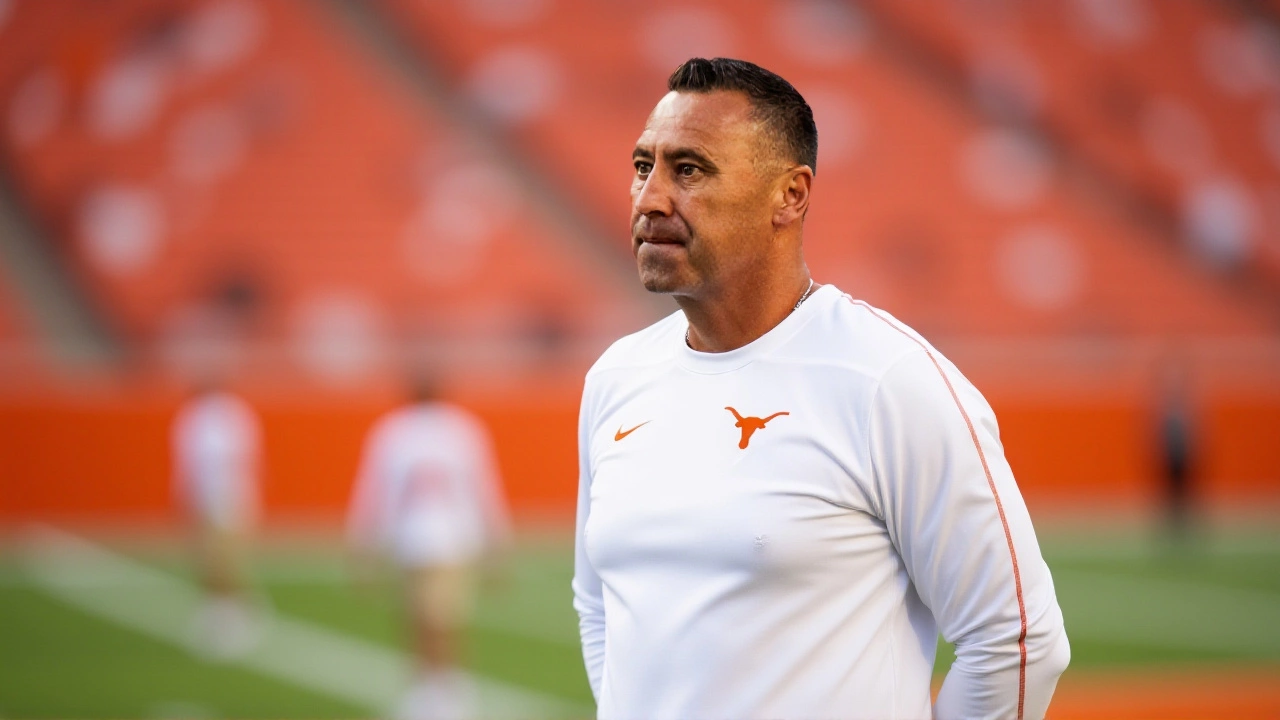ESPN Analysts Question CFP Rankings as Texas A&M’s Comeback and Oklahoma’s Upset Shake Playoff Picture

The College Football Playoff selection committee’s third rankings release on Tuesday, November 12, 2024 didn’t just rank teams—it ignited a firestorm of debate among ESPN’s top analysts. The Texas A&M Aggies landed at No. 3 despite analytics favoring them over both No. 1 Ohio State and No. 2 Indiana. The twist? The committee isn’t just looking at numbers. They’re watching film. And they’re trusting what their eyes tell them.
Eye Test Over Algorithms: The Texas A&M Paradox
Gregory McElroy, ESPN’s longtime analyst, didn’t mince words: "I HAVE NO ISSUES!" But his enthusiasm came with a caveat. "They’re going a lot on eye test here," he said during ESPN’s College Football Live broadcast. "If we’re going on rankings and analytics, Texas A&M is best analytically over Indiana and Ohio State—and they’re sitting at three. So they’re going a lot off of it."
That’s the real story. Texas A&M’s 31-30 comeback win over South Carolina on Saturday, November 9, 2024Kyle Field wasn’t just a win—it was a historical reset. The Aggies became the first SEC team in 287 attempts over the past 20 years to overcome a 27-point deficit. After trailing 30-3 at halftime, quarterback Marcel Reed went from 6-of-19 for 61 yards to 16-of-20 for 378 yards and three touchdowns. He finished with 439 passing yards and a miracle win. The committee didn’t just see a win—they saw resilience, poise, and a team that refused to quit.
Oklahoma’s Statement Win Shakes the Top 10
While Texas A&M was pulling off the unthinkable in College Station, Oklahoma was doing something just as seismic in Tuscaloosa. The Sooners’ 27-21 upset of previously No. 4 Alabama on November 9, 2024Bryant-Denny Stadium wasn’t just a win—it was a dismantling. Alabama, which had committed only six turnovers all season, coughed up three against Oklahoma. One of them? An 87-yard interception return by Ty Simpson that gave Oklahoma a 10-0 lead and sent shockwaves through the college football world.
Coach Kalen DeBoer’s team had been the model of discipline: outscores opponents 179-71 in the first half, led the nation in fewest turnovers. Now? Their aura is cracked. Alabama tumbled to No. 9 in ESPN’s power rankings. And suddenly, the committee’s toughest question emerged: How do you rank a two-loss team like Notre Dame against a one-loss Oklahoma that just beat Alabama on the road?
Notre Dame’s Tightrope Walk
Before Oklahoma’s win, Notre Dame was the clear top two-loss team. Their 33-7 demolition of Pitt on November 9 strengthened their résumé. Their defense is stingy. Their running game is physical. They’ve beaten top-10 teams. But now? Oklahoma’s win changes the calculus. "They’re likely a package deal—either above Notre Dame, or below them," said Pete Thamel in his November 12 projection.
Notre Dame still has games left against Boston College and Stanford. Win both, and they’re 10-2. But will that be enough? The committee has shown it values strength of schedule—and Oklahoma’s win over Alabama is now the most impressive victory of the season outside of Ohio State’s and Indiana’s undefeated runs. If Notre Dame finishes 10-2 and Oklahoma finishes 11-2, the committee will have to pick a side. And history suggests they’ll lean toward the team that beat the best.

The SEC’s Paradox and the Big 12’s Wildcard
The SEC has three teams in the top four: Texas A&M at No. 3, Georgia at No. 4, and Alabama at No. 9. But the conference’s depth is a double-edged sword. Only one SEC team can realistically make the playoff unless Georgia and Texas A&M both win out—and even then, the committee might hesitate.
Meanwhile, the Big 12 is a mess—and that’s good news for Oklahoma. Utah, Texas Tech, and BYU are all still alive. Utah’s two losses? To Texas Tech and BYU—both top-12 teams. That’s a stronger resume than Texas’s three losses, which include a humiliating defeat to Florida. "It wouldn’t be the first time a three-loss SEC team ranked ahead of two-loss teams," Thamel noted, referencing last year’s Alabama-Miami-BYU scenario. But this year? The committee might be less forgiving.
Projected Playoff Bracket: What’s on the Line
As of November 12, ESPN’s projected bracket is clear:
- No. 1: Ohio State (Big Ten champs, undefeated)
- No. 2: Indiana (Big Ten runner-up, undefeated)
- No. 3: Texas A&M (SEC champs, one loss)
- No. 4: Georgia (SEC, one loss)
First-round games will be hosted on campus December 19–20, 2024. The stakes? A shot at the national title. The pressure? Unbearable.

What’s Next? The Final Four Decider
Two weeks remain. And in those two weeks, the playoff picture could flip entirely. Will Indiana hold off a surging Michigan? Will Texas A&M beat Alabama in the SEC Championship? Will Oklahoma beat Oklahoma State and then a top-10 team in the Big 12 title game? And what if Notre Dame survives Boston College and Stanford with a win—and Oklahoma loses? The committee has made it clear: they don’t just look at records. They look at moments.
That’s why Marcel Reed’s second half in College Station matters more than any spreadsheet. That’s why Oklahoma’s win in Tuscaloosa is now the defining game of the season. The playoff isn’t just about wins. It’s about who you beat, when you beat them, and how you made the world believe in you again.
Frequently Asked Questions
Why is Texas A&M ranked higher than Ohio State and Indiana despite analytics favoring them?
The College Football Playoff committee prioritizes "eye test" over pure analytics. While models rank Texas A&M above Ohio State and Indiana based on strength of schedule and efficiency, the committee values dramatic wins—like A&M’s 27-point comeback against South Carolina—and perceived momentum. The Aggies’ resilience, leadership under pressure, and SEC pedigree outweigh statistical edges in the committee’s eyes.
How did Oklahoma’s win over Alabama change the playoff race?
Oklahoma’s 27-21 road upset of previously No. 4 Alabama shattered the Tide’s reputation for discipline and first-half dominance. The win gave Oklahoma the most impressive victory of the season outside of Ohio State’s and Indiana’s undefeated records. It forced the committee to reconsider whether a one-loss Oklahoma team deserves to leapfrog two-loss Notre Dame, making the Sooners a legitimate top-four contender.
Can a three-loss team like Texas make the playoff?
It’s unlikely. Texas has three losses, including a 31-14 defeat to Florida—a loss that hurts their résumé. Meanwhile, Utah’s two losses came to top-12 teams (Texas Tech and BYU), giving them a stronger profile. The committee has never ranked a three-loss team higher than a two-loss team in the modern CFP era, unless the three-loss team won the conference title. Texas won’t win the Big 12, making their case nearly impossible.
What’s the biggest factor the committee considers when ranking teams?
The committee prioritizes head-to-head results, strength of schedule, and quality wins—especially on the road. But they also weigh narrative: momentum, consistency, and how a team looks on film. A team that wins ugly might drop; a team that overcomes adversity, like Texas A&M, rises. Analytics are a tool, not the rule. The human eye still decides.
Will Notre Dame make the playoff if they finish 10-2?
It’s possible, but not guaranteed. Notre Dame’s defense and running game have impressed the committee, and their wins over top-10 teams give them credibility. But if Oklahoma finishes 11-2 and beats a top-10 team in the Big 12 Championship, the committee may favor Oklahoma’s resume over Notre Dame’s. The final decision hinges on whether the committee believes Oklahoma’s win over Alabama is more valuable than Notre Dame’s overall consistency.
Why is Georgia ranked ahead of Alabama despite both having one loss?
Georgia’s loss came in a close game against LSU, a top-10 team, and they’ve dominated every other opponent since. Alabama’s loss to Oklahoma was a complete collapse—three turnovers, no first-half offense, and a historic defensive breakdown. Georgia’s season has been more consistent, and their win over Florida and Tennessee carries more weight than Alabama’s wins over unranked teams. The committee sees Georgia as the more complete team.

